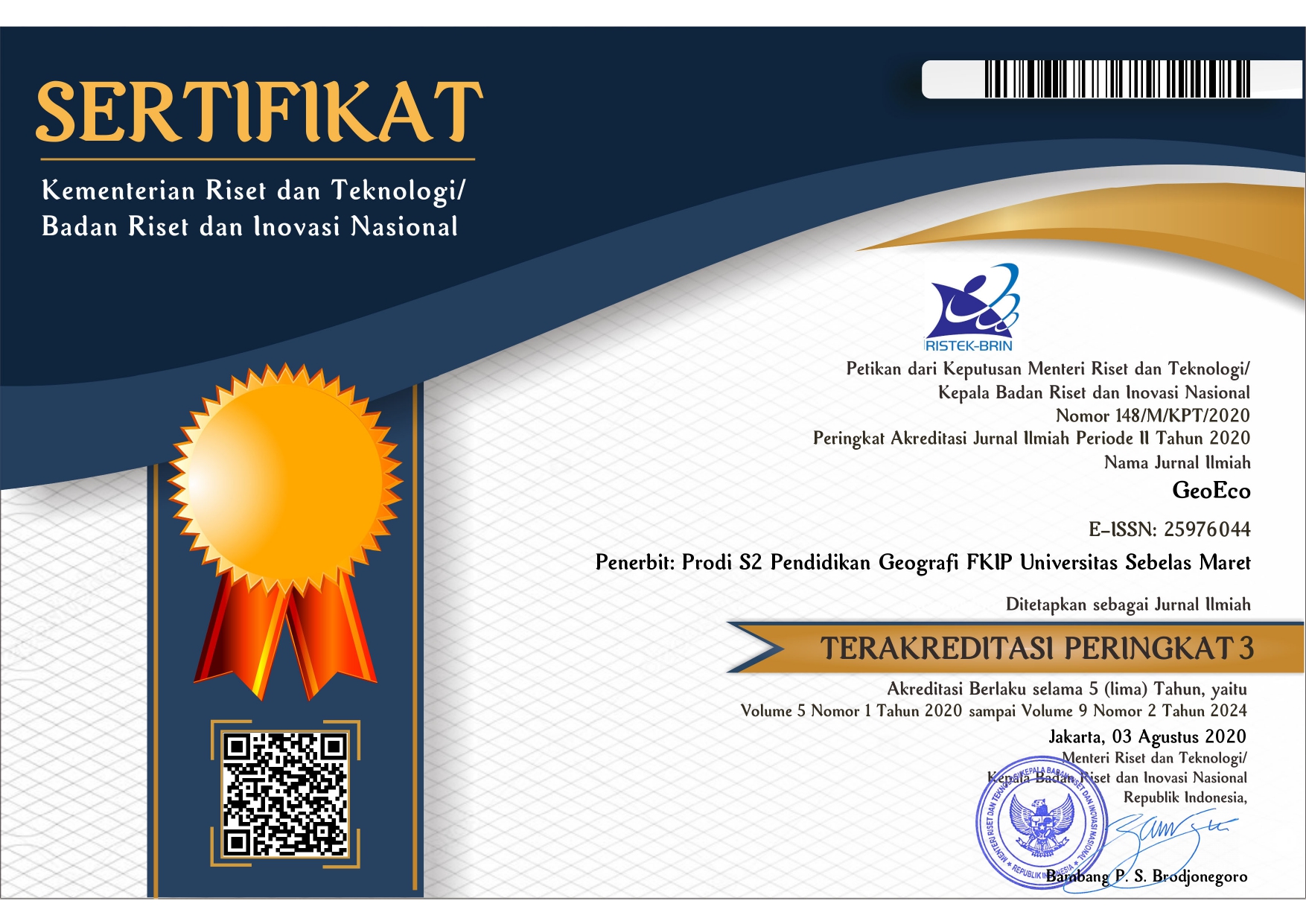ANALYSIS OF THE CYCLONE WIND HAZARD LEVEL BASED ON REMOTE SENSING AND GIS IN PONTIANAK CITY
Abstract
Keywords
Full Text:
PDFReferences
Blinn, C. M. (2012). Creation of a Spatial Decision Support System as a Risk Assessment Tool Based on Kentucky Tornado Climatology.
Changnon, S. A. (2009). Tornado losses in the United States. Natural Hazards Review, 10(4), 145–150.
Chen, J., Hagos, S., Feng, Z., Fast, J. D., & Xiao, H. (2023). The Role of Cloud–Cloud Interactions in the Life Cycle of Shallow Cumulus Clouds. Journal of the Atmospheric Sciences, 80(3), 671–686.
Chun, H., Chi, S., & Hwang, B.-G. (2017). A spatial disaster assessment model of social resilience based on geographically weighted regression. Sustainability, 9(12), 2222.
Dixon, R. W., & Moore, T. W. (2012). Tornado vulnerability in Texas. Weather, Climate, and Society, 4(1), 59–68.
Fernanda, A. G., Ihwan, A., & Adriat, R. (2024). Analisis Indeks Stabilitas Udara pada Saat Kejadian Angin Puting Beliung di Kota Pontianak. PRISMA FISIKA, 12(1), 6–19.
First, J. M., Ellis, K., Held, M. L., & Glass, F. (2021). Identifying risk and resilience factors impacting mental health among black and Latinx adults following nocturnal tornadoes in the US Southeast. International Journal of Environmental Research and Public Health, 18(16), 8609.
Forbis, D. C., Patricola, C. M., Bercos-Hickey, E., & Gallus Jr, W. A. (2024). Mid-century climate change impacts on tornado-producing tropical cyclones. Weather and Climate Extremes, 44, 100684.
Frazier, A. E., Hemingway, B. L., & Brasher, J. P. (2019). Land surface heterogeneity and tornado occurrence: an analysis of Tornado Alley and Dixie Alley. Geomatics, Natural Hazards and Risk.
Kaya, M. B., Alisan, O., Karaer, A., & Ozguven, E. E. (2024). Assessing Tornado Impacts in the State of Kentucky with a Focus on Demographics and Roadways Using a GIS-Based Approach. Sustainability, 16(3), 1180.
Kellner, O., & Niyogi, D. (2014). Land surface heterogeneity signature in Tornado climatology? An illustrative analysis over Indiana, 1950–2012. Earth Interactions, 18(10), 1–32.
León-Cruz, J. F., & Castillo-Aja, R. (2022). A GIS-based approach for tornado risk assessment in Mexico. Natural Hazards, 114(2), 1563–1583.
Mateo, J., Ballart, D., Brucet, C., Aran, M., & Bech, J. (2009). A study of a heavy rainfall event and a tornado outbreak during the passage of a squall line over Catalonia. Atmospheric Research, 93(1–3), 131–146.
Pasaribu, O. M., Poniman, A., Lestari, A. A., Prihanto, Y., Supriyadi, A. A., & Trismadi, T. (2023). AHP Scoring and Weighting Main Criteria For Assessment of Potential Hydrometeorological Disasters: A Literature Study. Journal of Applied Geospatial Information, 7(1), 755–761.
Payne, K. (2020). Impact of Land Cover on Tornadoes. University of Miami.
Pielke Jr, R. A., & Pielke Sr, R. A. (1997). Hurricanes: Their nature and impacts on society.
Sari, R. N. N. (2025). Mekanisme Angin Puting Beliung dan Dampaknya Pada Lingkungan. Jurnal TESLINK: Teknik Sipil Dan Lingkungan, 7(1), 231–239.
Service, N. W. (2022). Weather Related Fatality and Injury Statistics. Available online: https://www.weather.gov/hazstat/(accessed on 28 September 2024).
Strader, S. M., Ashley, W. S., Pingel, T. J., & Krmenec, A. J. (2017). Projected 21st century changes in tornado exposure, risk, and disaster potential. Climatic Change, 141, 301–313.
Syafitri, A. N., Maru, R., & Invanni, I. (2021). Analisis Tingkat Bahaya Bencana Angin Puting Beliung Berbasis Sistem Informasi Geografis Di Kabupaten Sidenreng Rappang. Jurnal Environmental Science, 3(2), 127–139.
Ulak, M. B., Kocatepe, A., Konila Sriram, L. M., Ozguven, E. E., & Arghandeh, R. (2018). Assessment of the hurricane-induced power outages from a demographic, socioeconomic, and transportation perspective. Natural Hazards, 92, 1489–1508.
Wang, C., Du, S., Wen, J., Zhang, M., Gu, H., Shi, Y., & Xu, H. (2017). Analyzing explanatory factors of urban pluvial floods in Shanghai using geographically weighted regression. Stochastic Environmental Research and Risk Assessment, 31, 1777–1790.
Refbacks
- There are currently no refbacks.












.png)

